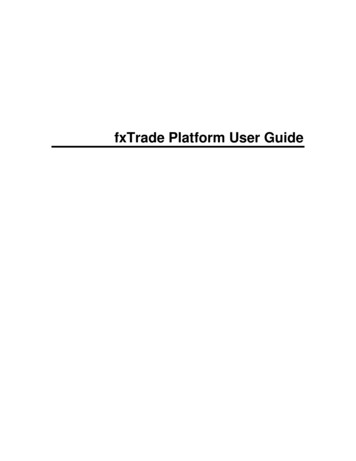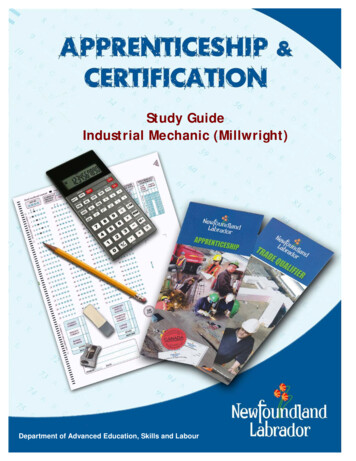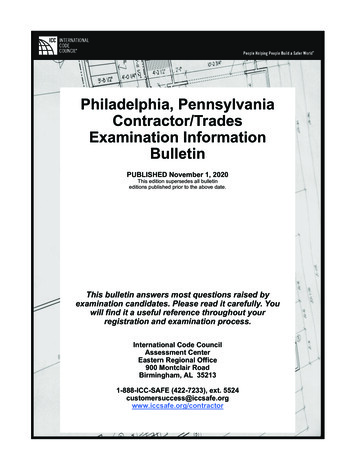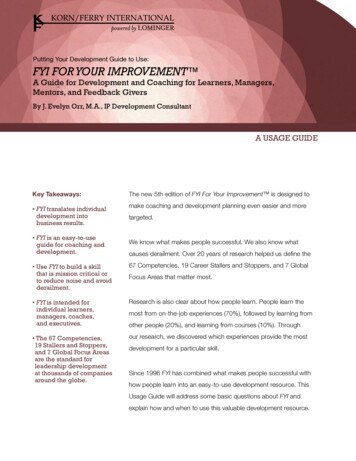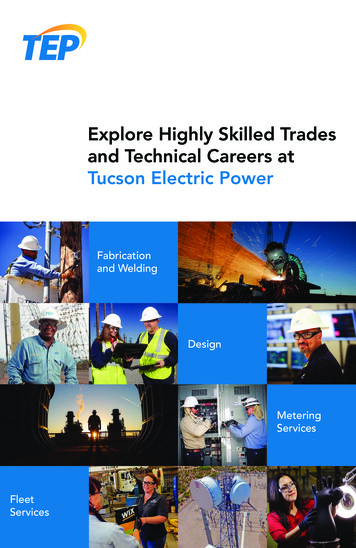
Transcription
Explore Highly Skilled Tradesand Technical Careers atTucson Electric PowerFabricationand WeldingDesignMeteringServicesFleetServices1
Contents23Introduction6Design8Electrical Communications Network9Electric Repair and Test Facility (ERTF)10Fabrication and Welding11Fleet Services12Heavy Equipment and Transportation (HEAT)13Line Construction, Operation & Maintenance14Metering Services16Quality Control Damage Investigation17Relay and System Protection18Substation Construction, Operation & Maintenance19Power Generation, Operation & Maintenance
A Dynamic and Growing IndustryThe energy industry is dynamic and growing due to new technologies,the expansion of renewable energy and the modernization of ourelectric grid. It offers many exciting careers with excellent wages formen and women of all backgrounds, especially for those who areinterested in working in the highly skilled trades.The Highly Skilled TradesTEP energizes our economy by delivering safe, reliable power to morethan 430,000 customers in the Tucson metropolitan area. Areas at TEPwith highly skilled trade and technical positions include design andconstruction, electronic communications, fleet services, fabricationand welding, and relay and system protection, among others.Highly skilled trades are occupations that require technical skills,knowledge and abilities, particularly in math and science. Technicalon-the-job training, apprenticeships or formal education provide theessential skills and knowledge required for these careers. Choosing acareer in this field offers an alternative to jobs that require a four-yearcollege degree.Registered with the State of Arizona, TEP apprenticeships offer paidon-the-job training and classroom training for up to five years andmentoring by experienced employees in the field. In some instances, apre-apprenticeship is a prerequisite to an apprenticeship.Employees in all of TEP’s skilled trade positions are represented by theInternational Brotherhood of Electrical Workers, Local 1116. These rolesmay require 24-hour emergency response, overtime and nonstandardwork hours.Excitingcareers withexcellentwages3
Inclusive workplacesproduce bright ideasAdvantages and Benefits ofa Skilled Trade CareerWorking in the skilled trades offersmany benefits, including: Excellent job placement andemployment opportunities in ahigh-demand field Highly competitive hourly wagesand benefits Paid on-the-job training A clear and direct careerpath with opportunities foradvancement Job opportunities nationwideTEP’s EmploymentBenefits PackageTEP offers a highly competitivewage and benefit package, andin addition: 401k retirement plan andemployer match Pension On-site fitness center On-site health care clinic Wellness program and incentivesMinimum EmploymentRequirementsApplicants for all positions mustpass a background check anddrug and alcohol tests, possess avalid driver’s license and have ahigh school diploma or GeneralEquivalency Degree. Candidatesalso may be required to passwritten, physical or other testsappropriate for the position anddemonstrate their competencyduring a job interview.4Our Commitment to Equal Opportunity,Inclusion and DiversityTEP is committed to the principles ofequal opportunity in recruiting, hiring, training,transferring, promoting and compensatingemployees. We recognize the duty to provideequal employment opportunities to all qualifiedindividuals.We comply with equal opportunity laws, whichprohibit discrimination in employment basedon gender, race, color, age, pregnancy, sexualorientation, gender identity, national origin,religion, disability, genetic information or any otherlegally protected characteristic. In accordance withfederal law, TEP has affirmative action plans torecruit and advance qualified minorities, women,people with disabilities and veterans.Inclusive workplaces produce bright ideas.We are stronger together and connected by ourshared purpose. As leaders in our workplace andcommunities, we will lead by example, work toremove barriers, seek out diverse perspectivesand champion progress.For questions about our non-discriminationpolicies or affirmative action plans, pleasecontact Human Resources.
Highly SkilledTrade andTechnicalJobs at TEPThis booklet is designed to helpyou explore highly skilled tradeand technical positions at TEP.It’s the first step to beginninga new career in energy. Thissection lists and describesapprenticeships and skilledtrade positions by departmentand includes a positionoutline, job prerequisites andrequirements, career path andhourly compensation for each.All of these positions receivehourly wages as negotiatedbetween the company andthe union.5
DesignOVERVIEWThe Design department plans, creates,tests and oversees the design andinstallation of electrical equipment onTEP’s grid. Projects include reinforcingthe system’s integrity, making systemupgrades and installing new residentialand commercial telecommunications.FIELD TECHNICIANPosition OutlineField Technicians participate in designingresidential projects and ensuring servicerequirements and standards are met. Theposition involves 75 percent fieldworkand some office work. Fieldwork involvesmeeting with customers to determinetheir needs, inspecting the job site andequipment and reading maps and prints.Office work includes coordinating projectswith other internal departments, workingwith distribution designers, using variouscomputer software programs and assistingwith customer communications.6Prerequisites & RequirementsAbility to pass a written math test thatincludes algebra, trigonometry, and basicknowledge of Ohm’s Law and electricaltheory, as well as a written mechanicaltest. Employees must be able to work inall weather conditions and walk, stoop,bend and twist. Must possess excellentinterpersonal and customer service skills.Progression PathThis is a two-year training program thatconsists of five steps. Steps 1-3 each takefour months to complete; steps 4-5 are eachsix months.Competitive CompensationStarting hourly pay: 23 Hourly pay upon completion: 41
DESIGNERPosition OutlineDesigners are responsible for designingcomplex jobs and commercial projectsthat meet TEP service requirements andstandards. Most of the work will be inthe office, with about 30 percent in thefield. Office work includes using softwareprograms to create and design projectsand researching standards, policies andprocedures. This position also coordinatesinternal work schedules, materials andinstallations. Knowledge of the TEPtransmission and distribution system isrequired. Fieldwork involves meeting withcustomers, conducting inspections andmonitoring project progress.Prerequisites & RequirementsAbility to pass a written math test thatincludes algebra, trigonometry and basicknowledge of Ohm’s Law and electricaltheory, and a written mechanical test.Physical requirements include being able towork in all weather conditions, walk, stoop,bend and twist. Must possess excellentinterpersonal and customer service skills.Progression PathEmployees must work as a Field Technicianfor two years and successfully complete afour-year training program before becominga Designer. Each of the eight steps in thetraining program are six months long.Competitive CompensationStarting hourly pay: 32 Hourly pay upon completion: 48 7
Electrical Communications NetworkDEPARTMENT OVERVIEWThe Electrical Communicationsdepartment uses state-of-the-arttechnology on a statewide network toensure communications are highly reliable,redundant and secure. Field devices monitorand control systems operations and transmitcritical data to the Energy ManagementSystem through a network of microwave andfiber optics. Using this information, SystemOperators monitor and control the operationof our local electrical system. In thisdepartment, technicians construct, maintainand troubleshoot equipment using a varietyof tools, test equipment, computers andengineered designs to ensure compliance.ELECTRONICS TECHNICIAN(COMMUNICATIONS)Position OutlineThe demand for skilled ElectronicsTechnicians is very high. Ongoing trainingin this rapidly evolving field is required.About 70 percent of the work is spent inthe field troubleshooting, problem solving8and programming software. Other tasksinclude constructing projects and testing andmaintaining equipment using engineeringdrawings. In-state and out-of-state travel isrequired.Prerequisites & RequirementsAbility to pass a written test on trigonometryand basic tool use. No practical test isrequired. Must be able to work comfortablyhigh above the ground and in all weatherconditions.Progression PathEmployees begin as an Electronics PreApprentice. After completing a minimumof one year of training, employees areeligible for a full apprenticeship. Apprenticesmust complete a four-year training programthat includes eight steps that are each sixmonths long.Competitive CompensationStarting hourly pay: 30 Hourly pay upon completion: 48
Electric Repair and Test Facility (ERTF)DEPARTMENT OVERVIEWThe Electric Repair and Test Facility testsand repairs distribution equipment, suchas transformers, regulators, reclosers,switchgear and capacitors. This departmentalso tests new equipment prior to itsinstallation in the field to ensure safety andquality, refurbishes and tests equipment sothat it can be reused again and evaluatestrial equipment and technology prior toinstallation.The Protective Goods Lab tests all theprotective goods used by field personnel,including rubber gloves, blankets, line hoses,hot sticks, grounds and jumpers. ERTF also isresponsible for processing wastes generatedby TEP according to environmentalregulations.DISTRIBUTION EQUIPMENT (SHOP)ELECTRICIANPosition OutlineThese employees primarily work in anindoor/outdoor shop environment. Thehighly mechanical work involves assemblingand disassembling equipment andcomponents. Technicians use computersto gather diagnostics information andtroubleshoot.Prerequisites & RequirementsAbility to pass a written test that includesalgebra word problems, basic electricaltheory and basic OSHA workplace safety.Must pass a practical test that includesproper lifting and body mechanics, followingdirections, basic mechanical skills andtool use. This job is moderately physicallydemanding, requiring an ability to stand, lift,bend and work in all weather conditions.Progression PathEmployees begin as an ERTF ShopElectrician Pre-Apprentice. Aftercompleting a minimum of one year oftraining, employees are eligible for a fullapprenticeship. Apprentices must completea four-year training program that includeseight steps that are each six months long.Competitive CompensationStarting hourly pay: 29 Hourly pay upon completion: 47 9
Fabrication and WeldingDEPARTMENT OVERVIEWThe Fabrication and Welding Shop supportsall internal departments that may needwelding or parts fabrication. The majority ofthe work involves power pole modifications,substation structural fabrication, fleet vehiclerepairs and miscellaneous projects. Mostof the work is done in the Fabrication WeldShop with occasional fieldwork.Prerequisites & RequirementsAbility to pass written and practical teststhat include OSHA Safety, welding processesand procedures, basic shop knowledge,personal protective equipment use, basicmath (addition, subtraction and division).Must be able to stand, climb and stoop,wear a respirator, and work in all weatherconditions.WELDING FABRICATORSPosition OutlineWelding Fabricators work primarily inan indoor/outdoor shop environmentperforming structural fabrication, repairingdamaged equipment and fieldwork. Workperformed will include mig, tig and stickwelding along with oxy-acetylene andplasma cutting.Progression PathWelding Fabricators begin as an EquipmentService Worker B and work for a minimumof one year before being eligible to test andqualify for an Equipment Service Worker Aposition.10Competitive CompensationStarting hourly pay for Equipment ServiceWorker B: 36 Starting hourly pay for Equipment ServiceWorker A: 42
Fleet ServicesDEPARTMENT OVERVIEWThe Fleet Services department selects,maintains, optimizes and manages all ofTEP’s fleet vehicles. Employees also performroutine inspections as well as tune-upsand repairs on a variety of vehicles. TheAutomotive Shop consists of mechanics of allvarious skill levels who work in a multiple-bayfacility with covered outdoor working space.Fleet Services also maintains an inventory offuel and replacement parts.AUTOMOTIVE SERVICE WORKERPosition OutlineAutomotive Service Workers spend 80percent of their time completing repairsin the shop with occasional field repairs.Daily tasks include performing preventativemaintenance and repairs on vehicles andheavy equipment.Prerequisites & RequirementsAbility to pass a written test that includeshigh school math, problem solvingand general mechanical automotiveknowledge. Must pass a practical testdisplaying advanced knowledge of vehiclecomponents and mechanics, work safety andcommunication and listening skills. Must beable to stand, stoop, lift and use appropriatemachinery and tools. Computer skills arerequired. Upon hiring, employees must beable to obtain and maintain a CommercialDriver’s License (CDL) with hazmatendorsements.Progression PathEmployees may begin as either anAutomotive Service Worker B or Adepending on their skills level. AutomotiveService Worker B includes a five-step trainingprogram with each step lasting six months.Automotive Service Worker A consists ofa one-year training program with two sixmonth steps.Competitive CompensationAutomotive Service Worker B startinghourly pay: 29 Automotive Service Worker B hourlypay upon completion: 35 Automotive Service Worker Ahourly pay: 42 11
Heavy Equipment and Transportation (HEAT)DEPARTMENT OVERVIEWheavy equipment operation. Must be ableThe HEAT department is responsible forto obtain and maintain a CDL and Craneoperating heavy equipment and transporting Certification.large loads within and outside of the state.Progression PathHEAVY EQUIPMENT & TRANSPORTATION Employees may begin as a HEAT PreOPERATORSApprentice or as a HEAT JourneyworkerPosition Outlineif they meet the qualifications. AfterHeavy equipment and transportationcompleting a minimum of one year ofoperators spend most of their time workingtraining, employees are eligible for a fullin crews in the field, operating cranes,apprenticeship. Apprentices must completebulldozers, loaders and backhoes. Theya three-year training program that includesalso perform manual labor and transporteight steps that are each six months long.equipment and rigging. Work entailsinterfacing with other internal departments.Competitive CompensationStarting hourly pay: 26 Prerequisites & RequirementsHourly pay upon completion: 42 Ability to pass written and practical testson OSHA workplace safety, basic math and12
Line Construction, Operation & MaintenanceDEPARTMENT OVERVIEWLine Construction, Operation andMaintenance is responsible for theconstruction, maintenance and repair of theoverhead and underground transmission,distribution and secondary lines of ourelectrical system. Crews work with veryhigh voltages ranging from 120 volts to500 kilovolts.Prerequisites & RequirementsAbility to pass a written test that includesbasic electrical theory, Ohm’s Law, algebra,geometry, basic trigonometry and OSHAworkplace safety. Must pass a practicaltest that includes mechanical and physicalaptitude, proper lifting techniques, problemsolving, following directions and recognitionand use of basic hand tools.LINEWORKERSPosition OutlineLine Construction crews work primarilyoutdoors in all weather conditions andfrequently at very high heights. The work isphysically demanding. Work crews repair,build and maintain lines and cables thatcomprise our local electrical grid. This highrisk work involves manual labor, mechanicalaptitude, climbing wood poles and workingin bucket trucks. Some work is in confinedspaces, such as utility access holes,underground vaults and trenches. Excellentcustomer service and communication skillsare required as crews interact with eachother, customers, first responders and thegeneral public.Progression PathEmployees begin as a Lineworker PreApprentice. After completing a minimum ofone year of training, employees are eligiblefor a full apprenticeship. Apprentices mustcomplete a four-year training program thatincludes eight steps that are each six monthslong. After becoming a Journeyworker,employees can pursue a position as a CrewLeader, Foremen or Troubleshooter.Competitive CompensationStarting hourly pay: 30 Hourly pay upon completion: 48 13
Metering ServicesDEPARTMENT OVERVIEWThe Metering department installs, readsand tests meters, and starts and terminateselectric service. Employees also areresponsible for responding to customerquestions and concerns regarding meteringand power supply issues.SINGLE PHASE METERING TECHNICIANPosition OutlineEmployees working in the Single Phasemetering department spend most oftheir time working alone in the field andinteracting with customers. The SinglePhase technician will be responsible forinstalling and exchanging various types ofsingle phase meters. They may conduct14service investigation orders such as highbill complaints and may install portablerecording test equipment on residentialcustomer services. Employees must be ableto work in all weather conditions and beavailable to work overtime.Prerequisites & RequirementsAbility to pass written and practical teststo include basic electrical theory, wordproblems and mechanical skills.Progression PathSingle Phase Metering Technicians receive6 months of training as a new hire.Competitive CompensationHourly pay: 35
THREE PHASE METERING TECHNICIANPosition OutlineEmployees working in the Three Phasemetering department spend most oftheir time working alone in the field andinteracting with customers. The technicianwill be responsible for diverse field worksuch as installing and maintaining primarymetering sites, as well as installing,servicing and maintaining substationmetering. Employees may conduct servicesinvestigation such as high bill complaints.They may also develop and maintainstandards for testing, wiring and installingand transformer rated metering equipmentand perform installation of portablerecording test equipment on residential andbusiness customer services. Employees maytest current and potential transformers andwork closely with the billing departmentto verify accuracy of meters with low orno consumption. Employees must be ableto work in all weather conditions and beavailable to work overtime.Prerequisites & RequirementsAbility to pass written and practical teststo include basic electrical theory, wordproblems and mechanical skills.Progression PathEmployees hired as a Three Phase MeteringPre-Apprentice must complete a minimumof one year of training before becomingeligible for a full apprenticeship. Apprenticesmust complete a four-year training programthat includes eight steps that are each sixmonths long.Competitive CompensationHourly pay: 29 Hourly pay after completion: 47 15
Quality Control Damage InvestigationDEPARTMENT OVERVIEWQuality Control Damage Investigators(QCDI) are sent into the field to investigatedamage to equipment and facilities. Damageinvestigation is of great importance becauseit determines financial liability for costlydamages and, in some cases, liability forpersonal injury or even death. The QCDIteam is exclusively responsible for locatingall TEP substations, SUNDT and Springervillegenerating stations and all projects on TEPproperty.QCDI works closely with many internaldepartments including: Design/Build,Systems Office, Outside Services, SubstationEngineering, Power Plant, FacilitiesMaintenance, Communication Engineeringand Telecommunications, among others.QUALITY CONTROL DAMAGEINVESTIGATORSPosition OutlineQuality Control Damage Investigators workprimarily in the field locating equipmentand investigating damage to our utilityequipment and facilities. They often workin all weather conditions. This position16communicates with systems operations, otherutilities and contractors. Investigators handleclearances, coordinate internal and externalwork, and communicate with the legal team.Employees must be self-driven. Weekly oncall duty assignments are required.Prerequisites & RequirementsAbility to pass a written test thatdemonstrates previous line locatingexperience, ability to draft and composereports, basic line locating and symbology,algebra, trigonometry, geometry, Ohm’s lawand Pythagorean Theorem. Must be fluentwith Arizona’s 811 Laws.Successful applicants must pass a practicalexam demonstrating the ability to accuratelylocate underground facilities using propersafety techniques.Progression PathThis position requires a two-year trainingprogram.Competitive CompensationStarting hourly pay: 28 Hourly pay upon completion: 40
Relay and System ProtectionDEPARTMENT OVERVIEWThe Relay Construction and Maintenancedepartment is comprised of highly-trainedtechnicians who are continuously learningin this evolving and specialized field. Powersystem protection is extremely important forproviding dependable and reliable service tocustomers, nearby utilities and the WesternGrid. The protection system senses troublein our system and makes the necessarycorrections and adjustments to prevent oravoid damage or hazards.RELAY TECHNICIANSPosition OutlineRelay Technicians test new and existingelectrical and protective relay equipmentin all weather conditions. They alsotroubleshoot and repair substationequipment, switchboard controls, meters,transformers, trip circuits, battery chargersand other electrical equipment. About 90%of the work is in the field troubleshooting,problem solving, constructing, readingengineering drawings and usingprogramming software. A small amountof time is spent in the office completingadministrative paperwork. Some local andout-of-state travel is required. Approximately60% of the fieldwork is performed on newcapital construction projects and 40% isperformed on maintenance and repair ofexisting equipment.Prerequisites & RequirementsAbility to pass a written test that includestrigonometry and basic tool knowledge anduse. Must be able to use computers andtablets.Progression PathEmployees begin as a Relay Pre-Apprentice.After completing a minimum of one yearof training, employees are eligible for a fullapprenticeship. Apprentices must complete afour-year training program that includes eightsteps that are each six months long.Competitive CompensationStarting hourly pay: 30 Hourly pay upon completion: 48 17
Substation Construction, Operation & MaintenanceDEPARTMENT OVERVIEWElectric power flows from a generatingstation to a substation and then to theconsumer. Substations increase voltage fortransmission or decrease it for distribution.Substations have devices that protectequipment within the substation, regulateelectrical conditions to maintain systemefficiency, monitor electrical conditionsand communicate information to acontrol center or to other substations andswitchyards. Employees who work in theSubstations department are responsible forconstructing, monitoring and maintaining allthe equipment within the substations andswitchyards.SUBSTATION ELECTRICIANPosition OutlineEmployees in the Substation departmentspend most of their time working in thesubstation yards doing electrical andmechanical work, using new technologiesand computer programs, testing andtroubleshooting, completing diagnosticsand repairs and doing routine maintenanceand construction. Substation Electriciansalso must read maps, prints, instruction18books and manuals and be able to followprocedures.Prerequisites & RequirementsAbility to pass a written test to includealgebra, geometry and basic Ohm’s Law.Ability to pass a practical test demonstratingprecise mechanical skills and tool usage,correct body position and safe operation ofa task. Ability to follow directions. Must beable to travel out of town, roughly estimatedat 10% of the time, and work in all weatherconditions. Must be able to work in ateam environment and have a high level ofcommunication skills.Progression PathEmployees begin as a Substations PreApprentice. After completing a minimum ofone year of training, employees are eligiblefor a full apprenticeship. Apprentices mustcomplete a four-year training program thatincludes eight steps that are each six monthslong.Competitive CompensationStarting hourly pay: 29 Hourly pay upon completion: 47
Power Generation, Operation & MaintenancePOWER GENERATION MAINTENANCEAND PLANT OPERATIONS TRADESPosition OutlineMaintenance personnel perform welding,machining and mechanical services tomaintain, troubleshoot and performnew installations on traditional steamboilers, internal combustion turbines andreciprocating internal combustion engines atsix plants across the state of Arizona. PlantOperators operate the systems that produceelectricity 24 hours a day, seven days aweek. They are divided between coal yard,outside auxiliary operator and control roomoperators. These trades are all responsiblefor safely and reliably operating andmaintaining high energy systems includingsteam systems, lube oil systems, hydraulics,pneumatics, controls, electrical switchgear,instrumentation, regulatory reporting,compressors, pumps, and cooling systemsamong others. These positions involve 85percent fieldwork and some office work.Fieldwork involves being on the job site,in one of the maintenance shops or in thecontrol room. Office work includes managinglogs, work orders, reading technicaldrawings or OEM manuals and interactingwith other departments. These roles havelimited interaction with the general publicas they are located on secure campusesdue to physical security and the industrialatmosphere.Prerequisites & RequirementsAbility to pass a written Edison ElectricalInstitute Mechanical Aptitude SelectionSystem (MASS), Plant Operator SelectionSystem (POSS B) or technical (TECH A)test battery. These tests measure skillsincluding reading, writing, comprehension,mathematics, spatial orientation, physics,mechanical concepts and visualization. Apractical physical evaluation of mechanicalskills and an interview is required for alltrades. Employees must be able to workin all weather conditions and walk, stoop,bend and twist. Must possess excellentinterpersonal and customer service skills.Progression PathThis is a two to four-year training programthat consists of up to eight steps. Themaintenance trades are state-registeredapprenticeships that are four-year programs.The operations programs are self-pacedand can take between two and four years tocomplete on average.Competitive CompensationStarting hourly pay: 30 Hourly pay upon completion: 48 19
Take the Next StepIf you have technical skills and experience and would like to workat TEP, please review the positions that are currently available attep.com/careers.Those who wish to pursue a technical career but need additionaltraining might consider completing the Energy Technology programoffered by Pima Community College. For more information, dex.html.Or, if you’d just like to learn more about technical careers atTEP, contact us at skilledtrades@tep.com.Explore MoreGet Into EnergyGetintoenergy.comU.S. Department of LaborApprenticeship.gov/become apprenticeUgly’s Electrical References Book, Jones & Bartlett Learning, LLCuglys.netPima Community College, Energy Technology Programpima.edu/programs-coursesInternational Brotherhood of Electrical Workers, Local 1116http://ibew1116.comU.S. Department of Labor, eArizona Department of Economic Security Apprenticeship nticeship20
welding or parts fabrication. The majority of the work involves power pole modifications, substation structural fabrication, fleet vehicle repairs and miscellaneous projects. Most of the work is done in the Fabrication Weld Shop with occasional fieldwo
